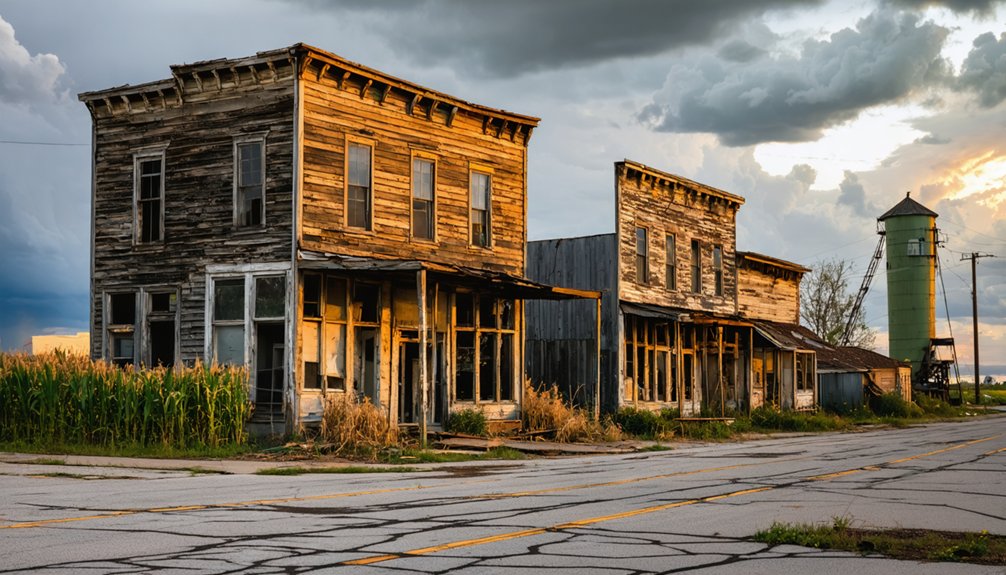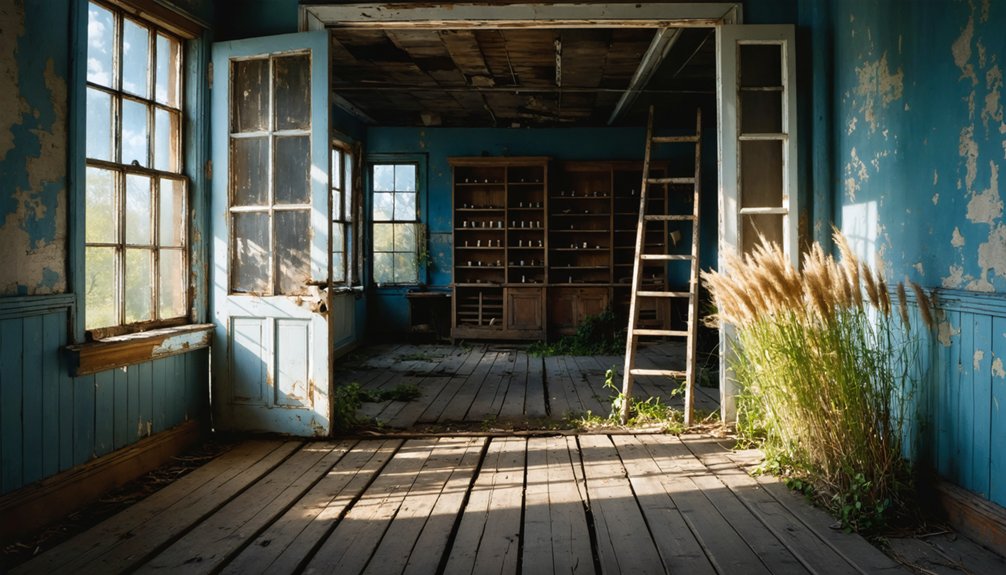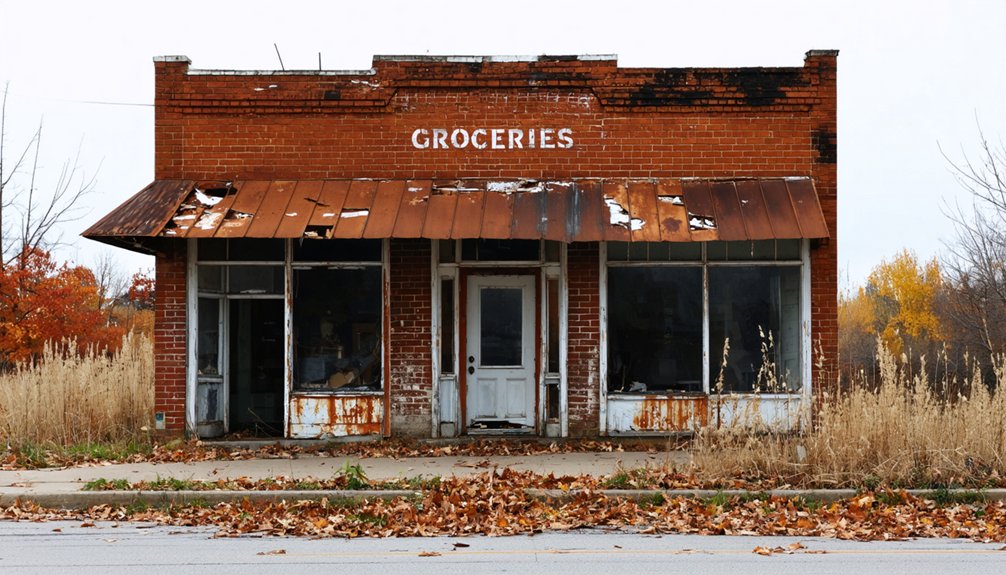You’ll find Unique, Iowa along the former McGregor Western Railroad line, where it flourished briefly as a bustling settlement of 1,500 residents in 1864. Within its first year, over 200 buildings, including 32 saloons, sprang up around the railroad depot and freight house. After an 1869 fire and the relocation of rail facilities to Calmar, the town’s fortunes declined until its post office closed in 1902. The site’s archaeological treasures and architectural remnants hold countless untold stories.
Key Takeaways
- Established in 1864 along the McGregor Western Railroad, Unique rapidly grew to 1,500 residents with over 200 buildings and 32 saloons.
- The town’s decline began after an 1869 fire and worsened when railroad facilities relocated to Calmar, leading to population loss.
- The post office closure in 1902 marked Unique’s final decline, following a pattern common to Iowa ghost towns.
- Coal mining and water-powered mills initially supported Unique’s economy, but resource depletion and stricter regulations led to closures.
- Archaeological excavations in 1986 uncovered 1,200 artifacts near Unique, preserving evidence of the town’s historical significance.
Unearthing the Lost Legacy
While modern Iowa’s landscape bears little resemblance to its ancient past, the 1986 excavation near Unique, Iowa revealed an extraordinary window into prehistoric life through more than 1,200 well-preserved artifacts.
You’ll find evidence of daily activities and ceremonial practices in the recovered items, from chert tool-making waste to sacred red pigments made from hematite and iron ore.
The site’s archaeological significance stems from its remarkably undisturbed condition, offering rare insights into the Woodland Culture period of 500-900 A.D. Similar to the Palace Site settlement, this location provides crucial understanding of early Iowa inhabitants.
Unlike many plowed-over locations across Iowa, Unique’s cultural heritage remains largely intact through its burial grounds and ceramic remnants.
The pristine burial sites and pottery fragments at Unique stand in stark contrast to Iowa’s typically disturbed archaeological locations.
These artifacts tell the story of a sophisticated society that once flourished here, preserving their traditions and practices for future generations to discover.
The discovery was prompted when the Iowa DOT planned to relocate the intersection of Highways 65 and 34, leading to a mandatory archaeological survey of the area.
A Once-Thriving Community
Although Unique began modestly in 1864 as a settlement along the McGregor Western Railroad, it rapidly transformed into a bustling hub of commerce and activity.
Within just one year, you’d have found yourself among more than 200 buildings, including 32 saloons that shaped the town’s vibrant community dynamics.
At its peak, this thriving community boasted 1,500 residents, making it larger than many contemporary Iowa settlements.
The town’s cultural heritage centered around its identity as a significant railroad stop, with a depot, side tracks, and freight house driving economic prosperity.
You would’ve witnessed a diverse mix of coal industry connections, retail establishments, and freight operations.
Like many Iowa ghost towns such as Carrollton, the town’s fate was sealed when the railroad chose a different route.
However, this golden age proved short-lived – an 1869 fire and the subsequent relocation of railroad facilities to Calmar triggered the town’s swift decline.
The town’s final decline accelerated when the post office closed in 1902 after railway engineers bypassed the settlement.
Daily Life and Social Fabric
Life in Unique centered around a vibrant mix of community gatherings and social events, where you’d find families coming together for festivals, church functions, and seasonal celebrations that strengthened neighborhood bonds.
You’d notice how extended family networks provided essential support systems, with relatives often living nearby and helping each other through agricultural challenges and economic hardships. The rise of major discount stores in nearby larger towns gradually eroded the economic stability of small local businesses.
Your daily work would have likely involved farming or coal mining, as these were the primary occupations that sustained the town’s economy before its eventual decline. Local religious groups like the Dunker community established strong ties within the town, shaping its social development.
Community Gatherings and Events
In modern-day Iowa, the Carroll County Historical Society keeps ghost town history alive through vibrant community gatherings and seasonal events.
You’ll find yourself immersed in local lore during their annual ghost town tours, which sell out quickly as participants explore multiple abandoned sites in a single day. The four-hour tours depart from the Carroll County Museum, blending education with social connection.
Throughout the year, you can join Halloween-themed events, spooky trails, and ghost hunts that bring the community together through costumed gatherings and storytelling sessions. Des Moines ghost tour guides share eerie encounters from the Iowa State Capitol and other haunted hotspots.
Local historians share tales of displaced peoples, mysterious cryptids like the “winged nightmare,” and historical hauntings.
Through live-streamed presentations and digital preservation efforts, these stories reach beyond physical gatherings, ensuring that the rich heritage of Iowa’s vanished communities endures for future generations.
Family Support Networks
Three key pillars formed the backbone of family support networks throughout Iowa’s ghost towns: voluntary community-based assistance, specialized housing support, and extensive educational programs.
You’d find strong family resilience emerging through in-home services that helped parents build skills without leaving their homesteads. Evidence-based programs received priority funding to ensure the highest quality support for families. Community connections strengthened as over 650 professionals reached out to 12,000 families statewide, offering 24/7 crisis support and parenting education.
If you were a young mother, you could access specialized programs combining childcare with education. Boys Town’s impact touched over 1,100 families annually, while transitional housing projects helped vulnerable households rebuild their lives independently. The dedicated team at SafeCare Health provided vital education and support for managing children’s medical conditions.
These networks proved essential in maintaining social fabric despite the isolation of rural settlements.
Occupations and Daily Work
Workers poured into Iowa’s ghost towns during their prime, drawn by diverse economic opportunities that shaped daily life.
You’d find a rich occupational diversity, from coal miners descending into dark shafts to railroad workers maintaining essential transportation links. Local merchants established general stores and inns along bustling main streets, while construction laborers built the infrastructure that kept these communities growing.
The daily grind wasn’t easy, with labor challenges ranging from dangerous mining conditions to the unpredictable nature of agricultural work. Many residents juggled multiple roles to make ends meet – farming their land while taking shifts at the railroad or helping construct new buildings.
Despite the hardships, these varied occupations created a web of economic interdependence that kept these now-vanished communities thriving during their heyday.
Economic Rise and Fall

While many Iowa ghost towns initially thrived as bustling railroad stops, their economic foundations proved tragically fragile.
You’ll find that Unique’s story mirrors the economic cycles that doomed countless Iowa settlements – from its promising start as a railroad hub to its eventual decline. The town’s fate was sealed by market shifts that rendered its single-industry focus obsolete.
When railroads shifted from steam to diesel locomotives, Unique lost its crucial role as a water and coal stop.
You could watch the town’s lifeblood drain away as nearby communities with more diverse economies drew away business and residents. Like many of its contemporaries, Unique couldn’t adapt when transportation patterns changed.
The closing of its post office marked the final chapter in its economic story.
Natural Resources and Industry
You’ll find Unique’s early growth was largely shaped by Iowa’s extensive coal mining operations, which by 1895 had established 342 mines employing over 6,000 miners across the state.
Water-powered mills along the tributaries of the Des Moines River attracted settlers and supported the town’s initial development through grain processing and lumber production.
The combination of abundant coal deposits and water resources made Unique a promising settlement until the mines began closing in the 1920s due to stricter government regulations and resource depletion.
Mining Operations Impact Growth
As coal mining emerged as the lifeblood of many Iowa towns in the late 19th century, it sparked rapid development and shaped entire communities like Buxton.
You’d find mining camps transforming into bustling towns, complete with housing, schools, stores, and taverns to serve the diverse workforce that flocked to these opportunities.
The mining cycles directly influenced population shifts, as towns could grow or disappear based on coal availability.
When a mine opened, you’d see communities spring up almost overnight. But these towns lived on borrowed time – most mines lasted only about ten years before depleting their resources.
Once the coal ran out, entire populations would pack up and move, sometimes literally hauling their houses to the next mining site, leaving ghost towns in their wake.
Water Mills Drive Settlement
During the early 1850s, water-powered mills became the cornerstone of Iowa’s pioneering settlements, with landmarks like Benjamin Talbott’s 1851 Iowa Falls mill and the historic Jeff Davis Mill from 1829 leading the way.
You’ll find these early water mills strategically positioned along Iowa’s abundant streams and rivers, particularly the Volga, where settlers harnessed the power of flowing water through carefully constructed dams.
The presence of water mills dramatically shaped settlement patterns throughout the region. As these mills processed grain and lumber using local materials, they attracted waves of settlers seeking economic opportunity.
You’ll notice how towns naturally grew around these industrial hubs, with mills like Bruce Mill near Stratford and Motor Mill in Clayton County serving as crucial community centers that spurred infrastructure development and agricultural expansion.
Architectural Remnants Today

While many Iowa ghost towns have vanished entirely, several architectural remnants still dot the rural landscape of towns like Buckhorn, Calhoun, and Corley.
You’ll find Buckhorn’s whitewashed church and creamery standing as private property, while Calhoun’s brick silo and cemetery remain as silent sentinels of its past.
In Rockville, you can spot the crumbling mill along the Maquoketa River, and in Stiles, the Lister family now owns the old post office and store buildings.
These abandoned structures tell stories of industrial decline and population shifts.
Each weathered wall and empty doorway whispers tales of communities transformed by time, progress, and changing fortunes.
While most historical remnants have surrendered to decay and overgrown vegetation, the cemeteries are often well-maintained.
You’re free to explore many of these sites, though some require permission as they’re on private land.
Local legends and photography opportunities abound in these atmospheric locations.
Stories From Former Residents
Beyond these weathered buildings and silent structures lie the vivid memories of those who once called these ghost towns home.
You’ll hear personal anecdotes of residents watching their towns slip beneath Lake Red Rock’s rising waters, as communities and even cemeteries were relocated.
Community memories paint a picture of Buxton’s thriving African-American mining culture, where workers earned competitive wages and built a distinctive society.
Former residents share stories of Bill Hedrick departing Athelstan for Civil War service, while others recall the cooperative spirit of Buckhorn’s farming families gathering at their local creamery.
Through these firsthand accounts, you’ll discover how railroad decisions transformed places like Rockville and Dyserville, with one town’s fortune spelling another’s demise.
Preservation Challenges

Preserving Iowa’s ghost towns presents mounting challenges as weather, vandalism, and funding limitations threaten these historic sites.
You’ll find buildings rapidly deteriorating under harsh seasonal conditions, while vandals strip away valuable architectural elements without oversight. The absence of local institutions accelerates this decay.
Preservation funding remains a critical obstacle. While state grants through the Iowa Economic Development Authority exist, they’re limited and often inaccessible to sites outside municipal boundaries.
Community engagement has dwindled as populations disperse, making it harder to maintain cultural memory and advocacy. Environmental threats compound these issues – from flooding that’s submerged entire towns to soil erosion that threatens remaining structures.
You’ll notice how changing land use patterns and vegetation growth continue to obscure these precious historical remnants.
Historical Significance
Despite preservation challenges, Unique’s historical footprint tells a compelling story of 19th-century Iowa settlement. You’ll find its legacy woven into Marshall County’s cultural heritage, representing a crucial chapter in Iowa’s westward expansion.
Like neighboring ghost towns Marietta, Minerva, and Capron, Unique emerged as part of the region’s agricultural and economic development.
While few historical artifacts remain, the town’s story mirrors the experiences of countless rural communities that once dotted Iowa’s landscape.
You can trace Unique’s rise and gradual decline through the familiar pattern of establishment, growth around local commerce, and eventual abandonment as transportation networks evolved.
The town’s history offers valuable insights into the economic forces, social structures, and community bonds that shaped Iowa’s rural development during this transformative period.
Frequently Asked Questions
Are There Any Ghost Hunting or Paranormal Reports From the Town?
You won’t find documented ghost sightings or paranormal investigations from Unique. Unlike Iowa’s other haunted locations, this ghost town hasn’t attracted ghost hunters or generated specific reports of supernatural activity.
What Happened to the Town’s Original Documents and Official Records?
Like scattered leaves in autumn wind, you’ll find the town’s original records dispersed – some likely reside in Iowa state archives, while others were lost during abandonment or moved to county historical preservation centers.
Did Any Famous People or Historical Figures Visit the Town?
You won’t find documented evidence of famous visitors to this location, though local historical significance drew regional figures like county officials and traveling merchants during its brief existence.
Were There Any Unsolved Mysteries or Crimes in the Town?
You’d be intrigued to know several unsolved disappearances haunted this area in the early 1900s. Local legends tell of missing travelers who vanished near the abandoned train depot, their fates forever unknown.
How Much Would Property in the Ghost Town Cost Today?
You’d likely pay between $250,000-$400,000 for property in this area today, based on regional real estate values and comparable ghost town sales, though exact prices depend on acreage and structures remaining.
References
- https://www.survivingateacherssalary.com/off-the-beaten-path-the-lost-towns-under-lake-red-rock-iowa/
- https://www.ruralhistorybuffs.org/lost-towns
- https://www.crawfordcounty.iowa.gov/about/forgotten_towns/
- https://www.youtube.com/watch?v=1J0Qx64ZrwI
- https://www.discoverguthriecounty.org/ghosttowns
- https://www.wabashtrace.org/trail-history-ghost-towns
- https://pubs.lib.uiowa.edu/annals-of-iowa/article/7045/galley/115796/view/
- https://opportunityiowa.gov/contacts/state-historic-preservation-office-iowa
- http://lucascountyan.blogspot.com/2012/07/vanished-archaeological-treasure.html
- https://history.iowa.gov/sites/default/files/history-sites-bloodrun-sitehistory.pdf



